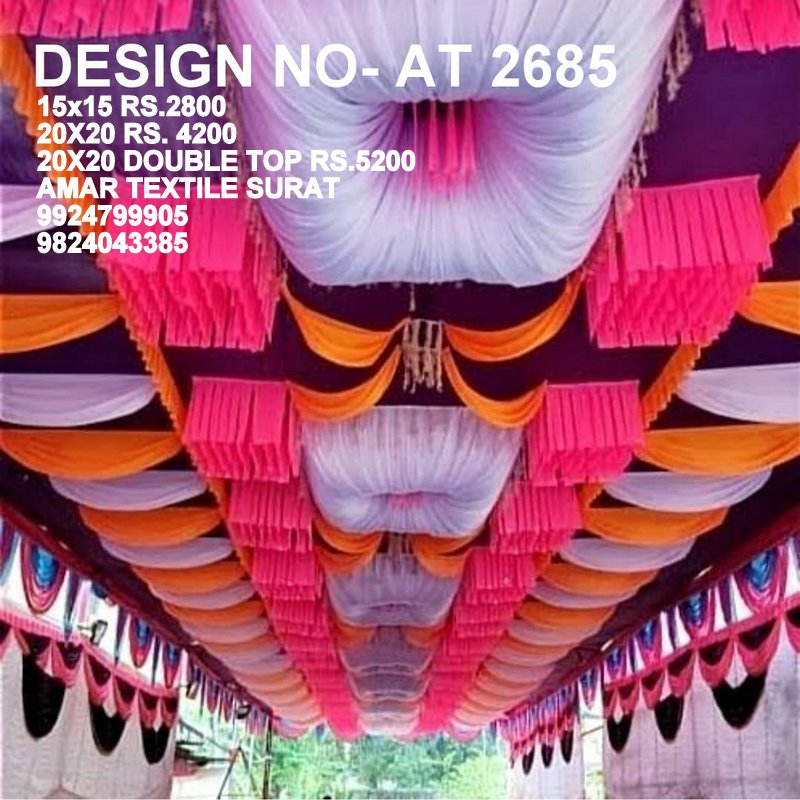DESIGN NO. 2685
₹2800.00
DESIGN NO. 2685
Traditional Hindu wedding stage decorations, particularly the mandap, are steeped in symbolism and cultural significance. Here's a description of common elements and ideas you might see in Ahmedabad, Gujarat, keeping in mind the rich traditions of the region:
The Mandap Structure:
- Four Pillars: The mandap is traditionally supported by four pillars, which hold deep symbolic meaning. They can represent the four Vedas (Rigveda, Samaveda, Yajurveda, and Atharvaveda), the four stages of life (Brahmacharya, Grihastha, Vanaprastha, and Sanyasa), or the four goals of human life (Dharma, Artha, Kama, and Moksha). In terms of material, these pillars can be made of wood, bamboo, or even adorned with ornate carvings or wrapped in fabric and flowers.
- Canopy (Gopuram): A canopy covers the top of the mandap, symbolizing the vastness of the universe and the blessings showering upon the couple. Traditionally, it's adorned with fabric in auspicious colors like red and gold, and often decorated with flowers or intricate designs.
Auspicious Colors:
- Red: A dominant color signifying love, passion, fertility, and auspiciousness. It's often used in drapes, flowers (especially roses), and the bride's attire.
- Yellow/Orange (Marigold): Represents purity, auspicious beginnings, and the sun's energy. Marigolds (genda phool) are extensively used in garlands and decorations.
- Gold: Symbolizes prosperity, wealth, and good fortune, often incorporated through fabric borders, decorative accents, or even golden-hued flowers.
- Green: Represents new beginnings, growth, and harmony with nature, often seen in leaves and some floral choices.
Floral Decorations:
- Marigold Garlands: Thick, vibrant garlands of marigolds are a quintessential element, used to adorn pillars, doorways, and create backdrops.
- Rose Arrangements: Roses, in shades of red, pink, and white, symbolize love and purity and are used in elaborate arrangements.
- Jasmine (Mogra): Its fragrant white blossoms symbolize purity and serenity and are often used in delicate strings and arrangements.
- Lotus: Representing purity, spirituality, and prosperity, lotus flowers or their motifs might be incorporated.
- Mango Leaves (Toran): Strands of fresh mango leaves are traditionally hung at the entrance of the mandap and other doorways, symbolizing prosperity and good luck.
Traditional Props and Elements:
- Sacred Fire (Agni Kund): A central element where the wedding rituals are performed, symbolizing purity and the divine witness to the vows. The area around it is often decorated with care.
- Kalash: A metal pot filled with holy water, topped with a coconut and mango leaves, symbolizing the universe and the source of life. It's often placed near the couple.
- Torans: Decorative door hangings made of marigolds, mango leaves, and sometimes other auspicious materials, welcoming guests and positive energy.
- Brass Lamps and Diyas: Traditional oil lamps add a warm glow and are considered auspicious.
- Rangoli: Colorful patterns created on the floor using colored powders, rice, or flower petals, welcoming guests and symbolizing good fortune.
Gujarati Influences:
- Mirror Work: You might see subtle incorporation of mirror work on fabrics or decorative hangings, reflecting the region's artistic traditions.
- Bandhani Patterns: Hints of the tie-dye textile art of Gujarat might appear in the fabric choices.
Overall Ambiance:
The traditional Hindu wedding stage aims to create a sacred, auspicious, and visually rich setting. The emphasis is on vibrant colors, fragrant flowers, and symbolic elements that have been passed down through generations. While modern interpretations exist, the core essence of tradition and its symbolic meaning remains central to the decoration.


